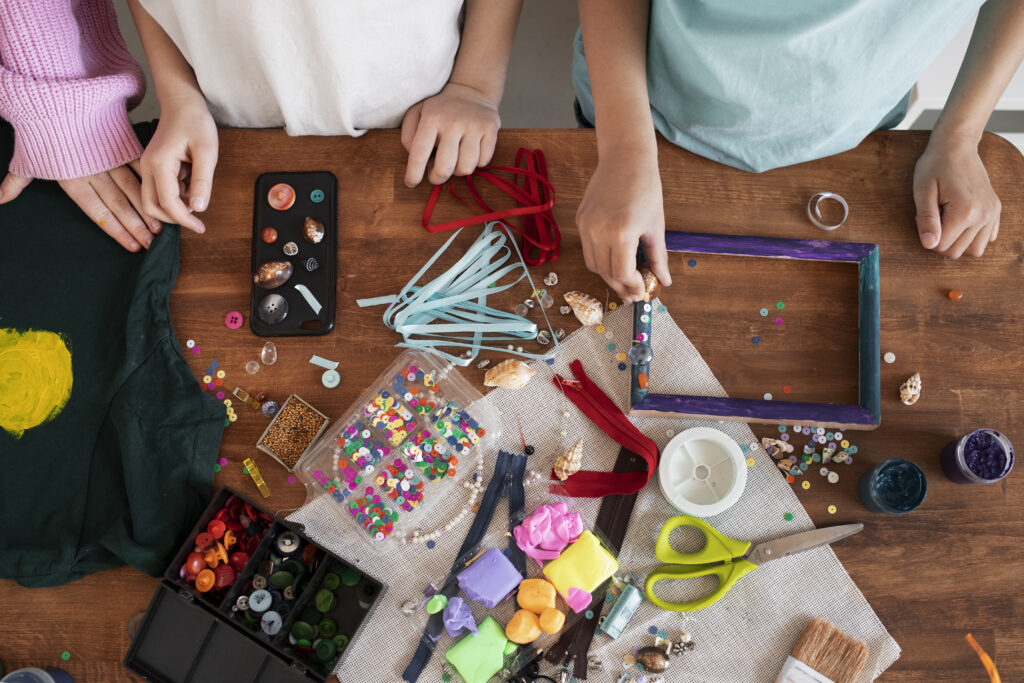Birth Order and Personality: Understanding Your Child’s Unique Traits

Birth order has long been a topic of fascination among parents and psychologists alike. It’s believed that a child’s position within the family—whether they’re the firstborn, middle child, or youngest—can influence their personality, behavior, and even the dynamics of their relationships. While every child is unique, understanding the general patterns associated with birth order can help parents foster stronger connections and create a harmonious family environment. Firstborn: The Responsible Leader Firstborn children often take on the role of the leader within the family. As the eldest, they tend to be more responsible, organized, and achievement-oriented. Parents often place higher expectations on firstborns, which can lead to traits like perfectionism and a strong drive for success. These children may also develop nurturing tendencies, stepping into a “mini-parent” role for their younger siblings. Key Traits of Firstborns: Parenting Tip: Encourage firstborns to relax and enjoy activities that allow them to unwind, such as activities for toddlers if they’re young or hobbies that don’t involve competition. Ensure they know it’s okay to make mistakes and prioritize fun alongside responsibility. Middle Child: The Diplomatic Peacemaker Middle children often find themselves in the role of mediator, balancing relationships between their older and younger siblings. They tend to be adaptable, social, and empathetic, as they’ve grown up navigating family dynamics. Middle children may seek their own identity outside of their siblings, often pursuing unique interests or friendships. Key Traits of Middle Children: Parenting Tip: During a family meeting, give middle children the opportunity to share their thoughts and feelings. This helps them feel valued and ensures their voice isn’t lost in the shuffle. Celebrate their unique interests to reinforce their individuality. Youngest Child: The Free-Spirited Charmer The youngest child often takes on the role of the family’s entertainer or free spirit. With older siblings to pave the way, the youngest tends to enjoy a more relaxed set of expectations. They’re often charming, creative, and adventurous but may also rely on others for support or decision-making. Key Traits of Youngest Children: Parenting Tip: While fostering the youngest child’s creativity, provide structure and encourage independence. Balancing freedom with responsibility ensures they grow into confident, capable individuals. How Birth Order Impacts Family Dynamics Understanding birth order can help parents create a harmonious family environment by recognizing and addressing the unique needs of each child. This aligns with mindful parenting, which encourages being present and attuned to your children’s emotional and developmental cues. Conscious co-parenting can also play a significant role in balancing dynamics. By collaborating on how to address each child’s individual needs, parents can reduce sibling rivalry and ensure that every child feels equally loved and supported. Tips for Navigating Birth Order Dynamics Stay Informed and Connected For more tips and insights on parenting strategies and child development, follow us on Instagram and YouTube. We share expert advice, practical tools, and real-life stories to empower your parenting journey. To stay updated on the latest research and resources, check out our press releases here for the most recent information on family dynamics and child behavior. Final Thoughts: Embracing the Unique Traits of Each Child Birth order provides a fascinating lens through which to view your children’s personalities, but it’s only one piece of the puzzle. By understanding their unique traits and tailoring your approach, you can nurture their growth, foster stronger relationships, and create a family environment where everyone thrives. Celebrate your firstborn’s leadership, your middle child’s diplomacy, and your youngest’s creativity. Together, these qualities make your family dynamic rich and special. Parenting is a journey, and with a little insight and intentionality, you can guide your children to become the best versions of themselves.
Guiding the Way: Understanding Lighthouse Parenting

Parenting is often described as one of life’s greatest journeys, and like any journey, it’s easier with a guiding light. That’s where lighthouse parenting comes in. This balanced approach emphasizes guiding children through life with care and attention, like a lighthouse providing direction to ships in the storm. It’s about being a steady, supportive presence while allowing your children to navigate their own paths. Lighthouse parenting blends the principles of conscious parenting with practical strategies for fostering independence, emotional resilience, and a sense of security. Let’s dive deeper into this approach and explore how it can transform your parenting journey. What is Lighthouse Parenting? Lighthouse parenting is a term coined by Dr. Kenneth Ginsburg, a pediatrician and child development expert. It’s based on the idea that parents should act as beacons of light—guiding their children safely through challenges while letting them explore and grow. This approach strikes a balance between being involved and giving children the space they need to learn from their experiences. Lighthouse parents provide structure, set boundaries, and instill values while encouraging independence and critical thinking. Key Principles of Lighthouse Parenting How to Practice Lighthouse Parenting 1. Set Clear Boundaries Children thrive with structure, but they also need flexibility to explore. Establish rules that are firm yet reasonable, and explain the reasons behind them. For example, holding a family meeting to discuss house rules ensures that children feel involved and understand the expectations. 2. Encourage Independence Give your child opportunities to make decisions appropriate for their age. Whether it’s letting toddlers choose their outfits or allowing older kids to plan their schedules, these experiences build self-reliance and problem-solving skills. 3. Focus on Emotional Development Lighthouse parenting emphasizes emotional intelligence. Teach your child to identify and express their emotions in healthy ways. This approach aligns with practices taught in child development classes online and supported by child development specialists. 4. Balance Support and Freedom Be there when your child needs you, but resist the urge to solve every problem for them. Offering guidance while allowing them to face challenges on their own builds resilience and adaptability. The Benefits of Lighthouse Parenting Tips for Starting Your Lighthouse Parenting Journey Stay Informed and Empowered For more tips on parenting styles and strategies, check out our press releases here and follow us on Instagram and YouTube. We offer expert advice and real-life examples to empower your parenting journey. Final Thoughts: Lighting the Path for Your Child Lighthouse parenting is about finding the balance between providing guidance and allowing independence. By being a steady, supportive presence, you’re equipping your child with the tools they need to navigate life’s waters confidently. Embrace the journey, trust in your parenting instincts, and remember that your love and guidance are the most important beacons in your child’s life. Together, you’ll create a foundation of trust, resilience, and connection that will carry them through life’s challenges and triumphs.
Mental Health in Children: Recognizing Signs and Supporting Well-being

The mental health of children is an increasingly pressing issue. Paediatricians and mental health professionals are raising alarms as children face unprecedented challenges, including the lingering effects of the pandemic and growing societal pressures. As parents, it’s crucial to be vigilant in recognizing early signs of distress, as these can pave the way for early intervention and support. Let’s explore the initial signs of mental health struggles in children and how we, as parents, can guide them through these challenges with compassion and mindful parenting. Recognizing the Signs of Distress Children often express mental distress differently than adults, so it’s essential to understand their behaviors and emotions from a developmental perspective. Here are some initial signs that may indicate your child is struggling: What to Do When You Notice Signs of Distress If you observe any of these behaviors, it’s essential to approach the situation with patience and empathy. Conscious parenting encourages us to be fully present with our children, acknowledging their emotions without judgment. Finding Supportive Resources It’s also helpful to seek out resources that align with your child’s needs. From child development classes online to community-based programs, there are numerous avenues for gaining insight into your child’s mental health journey. Access to best parenting resources can empower you as a parent to support your child effectively and understand their unique needs. Fostering Mental Health through Community No parent should have to navigate these challenges alone. Following parenting-focused communities on social media, such as our Instagram and YouTube channels, can provide valuable tips, expert interviews, and support from other parents who may be facing similar situations. Sharing stories, resources, and insights can create a sense of community that strengthens our parenting journey. Final Thoughts: Your Role in Supporting Your Child’s Mental Health Supporting your child’s mental health is an ongoing journey that requires compassion, patience, and a commitment to understanding. Remember, noticing signs of distress is not a reflection of failure but an opportunity to strengthen your bond and guide them through life’s challenges.If you’re ever unsure, remember that reaching out for help is a powerful step toward supporting your child. Together, through mindful parenting and open communication, we can create a safe, nurturing environment where children feel seen, heard, and loved. Let’s walk this path with courage, knowing that each moment of connection helps build resilience and a brighter, healthier future for our children.
Crafts with Kids: Fun, Connection, and Learning Without the Mess

Crafting with kids is more than just a fun activity—it’s a wonderful way to foster creativity, boost development, and spend meaningful time together. Craft activities encourage children to explore their imagination, develop fine motor skills, and learn patience. As a parent, you may worry about the potential mess or how much effort it takes to get everything organized, but there are plenty of low-key crafts that keep your home intact and still engage your child. Why Crafts Are Beneficial for Kids Crafting offers a range of developmental benefits for children. Engaging in crafts can improve fine motor skills, as children cut, glue, or color. It encourages problem-solving as they figure out how to construct something or think creatively. Crafts also provide an opportunity for parent-child bonding; by working together, you’re sharing experiences, communicating, and building memories that last. Moreover, crafts foster a sense of achievement. When kids complete a project, they feel proud of their work, boosting their self-esteem and encouraging them to try new things. This is where mindful parenting comes in; being present and actively participating in your child’s crafting experience allows you to see the world through their eyes and reinforces the connection between you. Low-Key Craft Ideas to Minimize the Mess Here are a few easy, low-key craft ideas that engage children without causing chaos in your home: Tips for Mess-Free Crafting To make sure crafting remains a stress-free experience, here are a few tips: Bonding and Learning Through Crafts Crafting together can also serve as a great tool for conversation. Holding a family meeting to discuss upcoming craft ideas or letting your child choose the materials for a project can foster independence and make them feel valued. These activities also help children understand collaboration and patience. Crafting time is a perfect example of conscious co-parenting too, where both parents can get involved, share responsibilities, and enjoy the creative journey with their children. Plus, when kids see their parents involved, they’re often more excited to participate and learn. How Crafts Benefit Parents Too Crafting isn’t just beneficial for kids; it’s rewarding for parents as well. Watching your child’s creativity unfold can bring immense joy, reminding you of the importance of slowing down and enjoying simple pleasures. As a parent, crafting offers you a chance to be fully present with your child, which is at the heart of conscious parenting. Crafting can also give you insights into your child’s thought process, helping you understand their preferences and strengths. This perspective can be valuable as you explore child development resources or consider child development classes online to support your child’s learning journey. Final Thoughts: Make Crafting a Regular Bonding Activity Crafting with your child is a meaningful way to encourage creativity, support development, and strengthen your connection. It doesn’t have to be elaborate or messy to be effective. With simple, low-key projects, you can enjoy all the benefits of crafting without the stress. For more tips on activities that enhance family bonding and support your child’s growth, don’t forget to follow us on Instagram and YouTube. We share insights, tutorials, and ideas that make parenting and family life fulfilling and fun. Remember, the moments spent creating and connecting with your child are precious. Embrace them, enjoy them, and watch as your bond grows stronger with each masterpiece created together.
Self-Care for Parents: Prioritizing Your Well-being to Thrive in Parenting

Parenting is an all-encompassing role, one that often leaves parents with little time for themselves. Yet, as the familiar saying goes, we need to “put on our own oxygen mask first” to be the best caregivers we can be. Practising self-care isn’t selfish—it’s essential for both you and your family. Maintaining boundaries and finding ways to nurture yourself is a gift to your children, allowing you to show up as a calm, resilient, and attentive parent. Why Self-Care Matters in Parenting When parents are well-rested, emotionally balanced, and fulfilled, they can better handle the demands of parenting. Self-care supports family well-being by helping parents manage stress, model healthy behaviors, and foster a nurturing home environment. Children are observant; when they see their parents taking care of their own needs, they learn the importance of respecting boundaries and prioritizing mental health. Incorporating mindful parenting into your daily life can serve as a form of self-care. Mindfulness allows you to remain present, reducing feelings of overwhelm and making it easier to connect with your child on a deeper level. Setting Healthy Boundaries in Parenting Boundaries are a form of self-care, helping you define where your personal needs end and where your parenting responsibilities begin. These boundaries aren’t about creating distance but about protecting your energy and emotional well-being. Healthy Ways to Put Your Oxygen Mask On First Modeling Self-Care for Your Children When children witness their parents caring for themselves, they learn that self-care is valuable and necessary. Conscious parenting encourages parents to set examples that children can carry forward into their own lives. By demonstrating that self-care is a priority, you’re showing your child that boundaries, self-respect, and personal time are essential aspects of a balanced life. Finding Resources and Community If you’re looking for ways to incorporate more self-care into your routine, explore resources like child development classes online or follow our Instagram and YouTube channels. We share practical tips, supportive insights, and real-life stories to empower your parenting journey and offer tools for self-care along the way. Final Thoughts: Self-Care is Essential for Thriving in Parenthood Remember, self-care isn’t about indulging in luxury but about meeting your basic needs with kindness and respect. Taking time for yourself doesn’t mean taking away from your child—it means investing in the resilience and strength that both you and your family benefit from. Embrace self-care as a crucial element of parenthood, and watch as it positively transforms your relationship with your children, your partner, and, most importantly, yourself. Your well-being is a gift to your family, so treat it with the care and attention it deserves. Start today by setting one small boundary, dedicating a few minutes to yourself, and committing to the journey of nurturing your own well-being alongside your role as a parent.
Working Motherhood: Finding Balance and Creating Boundaries

The landscape of motherhood has changed dramatically over the past few decades. Whether driven by passion or necessity, more mothers are working than ever before. For many women, working motherhood is a delicate balancing act—juggling professional responsibilities with the demands of raising a family. It’s a role that comes with its unique set of challenges but also offers opportunities for personal growth and fulfilment. If you find yourself in this position, you’re not alone, and you deserve all the encouragement in the world. Embrace Imperfection: Balance is Elusive First things first: balance is elusive. The idea of having everything perfectly balanced at all times is more myth than reality. On some days, you’ll feel like you’re acing your job but falling short at home. On other days, you’ll be present for your family but struggle to meet a deadline at work. And guess what? That’s okay. It’s essential to permit yourself to be imperfect. Recognize that balance doesn’t mean doing everything equally well at all times. It’s about finding a rhythm that works for you and your family. Remember that family well-being doesn’t hinge on perfection but on your presence and love, even if things feel chaotic sometimes. Prioritize Self-Care When you’re managing both work and family, it’s easy to forget about yourself. But self-care isn’t a luxury—it’s a necessity. Taking care of your mental and physical health is crucial for managing the demands of working motherhood. Prioritize small moments of rest and relaxation. Whether it’s enjoying a cup of coffee in silence before the day starts or squeezing in a quick walk during lunch, these little acts of self-care help you recharge and show up as the best version of yourself. Set Clear Boundaries One of the most important aspects of maintaining your well-being is creating boundaries between your work and family life. This might mean setting specific hours when you are unavailable for work, such as family dinner time or weekend activities. It might also mean designating a workspace at home that’s separate from the living areas, so there’s a clear distinction between work mode and family time. Boundaries aren’t just about time—they’re also about emotional energy. If work stress is bleeding into your home life, find ways to compartmentalize. Establishing these boundaries not only protects your well-being but also enhances the parent-child bonding that’s so essential to your family dynamic. Practical Tips for Finding Balance Leverage Community and Resources No one should have to navigate working motherhood alone. Leverage the resources around you, whether that’s through your employer’s support programs or external tools like child development classes online that can help guide your parenting journey. Additionally, our website offers a treasure trove of resources designed to support working mothers, from time management tips to strategies for managing stress. Final Thoughts: You’re Doing Great The truth is, working motherhood isn’t easy, but you are doing a great job. You can successfully manage both roles by focusing on your priorities, setting boundaries, and being kind to yourself. Your children are watching how you handle these challenges, and they will benefit from seeing you work hard while also caring for them deeply.If you’re ready to dive deeper into this journey, follow us on Instagram and YouTube for daily insights, encouragement, and actionable tips that will empower you in your role as a working mother. Together, we can redefine what it means to balance work and motherhood while ensuring your family and your well-being thrive.
Should We Set Screen Time Boundaries?

As technology becomes increasingly embedded in our daily lives, many parents are asking the same question: should we set screen time boundaries for our children? Screens are everywhere—whether it’s smartphones, tablets, computers, or televisions—and while technology brings undeniable benefits, the growing concern about its impact on child development is hard to ignore. So, what does the research say about the effects of prolonged screen time on the brain, and are all forms of technology equally harmful? The Impact of Screen Time on the Developing Brain Recent studies have shown that excessive screen time can have negative effects on a child’s brain, particularly during the critical stages of development. The brain undergoes rapid growth in the early years, and this is when cognitive functions, emotional regulation, and social skills are forming. Research indicates that too much screen time can impair these essential areas by affecting the brain’s structure and connectivity. For instance, one study published by the National Institutes of Health (NIH) found that children who spent more than two hours a day on screens performed worse on language and thinking tests. Moreover, those who engaged in over seven hours of screen time per day showed thinning of the cortex, the area of the brain responsible for critical thinking and reasoning. Excessive screen time has also been linked to issues with parent-child bonding. When parents and children spend more time on their devices, opportunities for face-to-face interactions—such as playing, reading, or simply talking—become fewer, impacting emotional development and family connection. Are All Forms of Technology the Same? Not all screen time is created equal. It’s important to distinguish between passive screen time—like watching TV shows or scrolling through social media—and interactive, educational forms of screen use. For instance, certain apps and games designed for child development can be beneficial, especially when used in moderation and under supervision. Interactive technology that encourages problem-solving, creativity, and critical thinking may have positive cognitive effects, but the key is moderation. Even the most educational content can have negative consequences when it dominates a child’s day or prevents them from engaging in other important activities, such as outdoor play, exercise, and family interaction. Mindful parenting plays a crucial role in how children interact with technology. Parents can set healthy examples by modeling good digital habits, engaging in co-viewing practices, and making screen time more interactive by discussing content with their children. This approach ensures that screen time becomes a shared experience rather than an isolating one. Does Classroom Screen Time Have the Same Impact? Technology is now a vital tool in classrooms, providing students with interactive learning opportunities that weren’t available a few decades ago. But does screen time in a classroom setting carry the same negative effects as recreational screen time? Educational screen time is generally viewed more favorably than recreational use. Research suggests that technology can enhance learning experiences, offering interactive tools and resources that help children grasp complex concepts more easily. Programs that promote child development classes online or stimulate critical thinking can be beneficial when implemented with structure and purpose. However, it’s still essential for educators to maintain balance. Children benefit from both digital and non-digital learning experiences, and too much reliance on technology in the classroom could still contribute to attention issues or reduced face-to-face social interactions. Practical Tips for Setting Screen Time Boundaries So, how do we balance the benefits of technology with the need to protect our children’s developing brains? Final Thoughts While technology is an integral part of modern life, setting boundaries is crucial for the healthy development of our children. Screen period can be beneficial when used intentionally, but as with anything, balance is key.If you’re looking for more tips on managing screen period and fostering a healthy family environment, follow us on Instagram and YouTube for ongoing advice and insights that will empower your parenting journey. Together, we can navigate the digital age while supporting our children’s growth and well-being.
Protecting Your Marriage in the Midst of Parenthood

Parenthood is a beautiful journey, but it can sometimes overshadow the relationship that started it all—your marriage. It’s easy to become consumed by your child’s needs and, without realizing it, place your marriage on the back burner. While a child-centered home might sound ideal, when the marriage suffers, so does the child. A strong spousal relationship is the foundation for a healthy family, and protecting it during the busy season of parenting is essential for both your marriage and your child’s well-being. Why Protecting Your Marriage Matters Children thrive in environments where they witness love, respect, and cooperation between their parents. Mindful parenting teaches us to focus on emotional awareness and nurturing our children’s needs. But how can we effectively parent if we aren’t nurturing the most important relationship in the family? Studies show that marital satisfaction significantly affects not only the parents’ well-being but also the emotional stability of the child. Therefore, a healthy marriage is just as essential as family well-being. Tips for Protecting Your Marriage While Parenting Prioritize Communication: Amid the chaos of parenting, finding time to talk can feel impossible. But it’s essential. Scheduling regular check-ins with your spouse can help both of you stay on the same page. Whether it’s discussing parenting approaches, dividing household duties, or just sharing your thoughts and feelings, open communication is crucial for protecting your relationship. These regular chats also serve as a family meeting between you two, reinforcing the foundation of your partnership. Schedule Date Nights: Just because you’re parents doesn’t mean date nights are a thing of the past. Protecting your marriage requires intentional time together. Find a babysitter or swap kid-free time with another family and get out of the house! Whether it’s a quiet dinner, catching a movie, or simply taking a walk, spending one-on-one time strengthens your bond and allows you to reconnect as a couple. Set Boundaries Between ‘Parent’ and ‘Partner’: It’s easy to lose your identity as a partner when you’re deep in the trenches of parenting. While your role as a parent is important, it’s vital to set boundaries and allow time for your role as a partner. You’re still two individuals in a relationship outside of your parenting responsibilities. Acknowledge this with small gestures—like leaving each other notes, sharing a cup of coffee before the kids wake up, or simply asking how their day was. These small moments add up and remind both of you that your relationship matters. Share the Load: Parenting is a team effort. Dividing and conquering tasks—whether it’s school runs, meal preparation, or bedtime routines—helps alleviate stress and prevents one partner from feeling overwhelmed. A conscious co-parenting approach ensures that both parents are actively involved, making the relationship feel more balanced. This teamwork reinforces the fact that you’re not only partners in parenting but also in life. Remember the Long Game: Kids grow up fast, but marriages are intended to last a lifetime. During the most challenging days, remind yourselves that you’re in this together for the long haul. The challenges you face today will pass, but the bond you build by working through them will strengthen your marriage in the future. Learn and Grow Together Parenting is an evolving journey, and it can help if both you and your spouse continue learning together. Whether it’s reading parenting books, attending workshops, or taking child development classes online, growing together as both partners and parents strengthens your marriage. This is also a great opportunity to model lifelong learning and collaboration for your children. Explore Our Resources If you’re looking for more support in balancing parenting and marriage, we’ve got you covered. Our website offers a variety of resources, including parenting tips, articles on conscious parenting, and tools to help you maintain a strong partnership while raising children. Additionally, don’t forget to follow us on Instagram and YouTube for ongoing tips, tools, and insights that will empower your parenting journey while keeping your marriage strong. These platforms offer real-life examples, practical advice, and expert interviews that can help you maintain balance. Final Thoughts Your marriage is the bedrock of your family. By protecting your relationship during the busy parenting years, you’re not only ensuring a strong connection with your spouse but also modeling a healthy partnership for your children. Prioritize communication, make time for each other, and remember that while parenting is important, your marriage deserves care and attention too. Start small—schedule a date night, send a loving text, or check in with your spouse today. You’ll be surprised at how these simple acts can transform your relationship and strengthen your family dynamic.Ready to take the next step in protecting your marriage? Visit our website for more tips and resources, and don’t forget to follow us on Instagram and YouTube for practical advice that will help you nurture your marriage while raising a thriving family.

